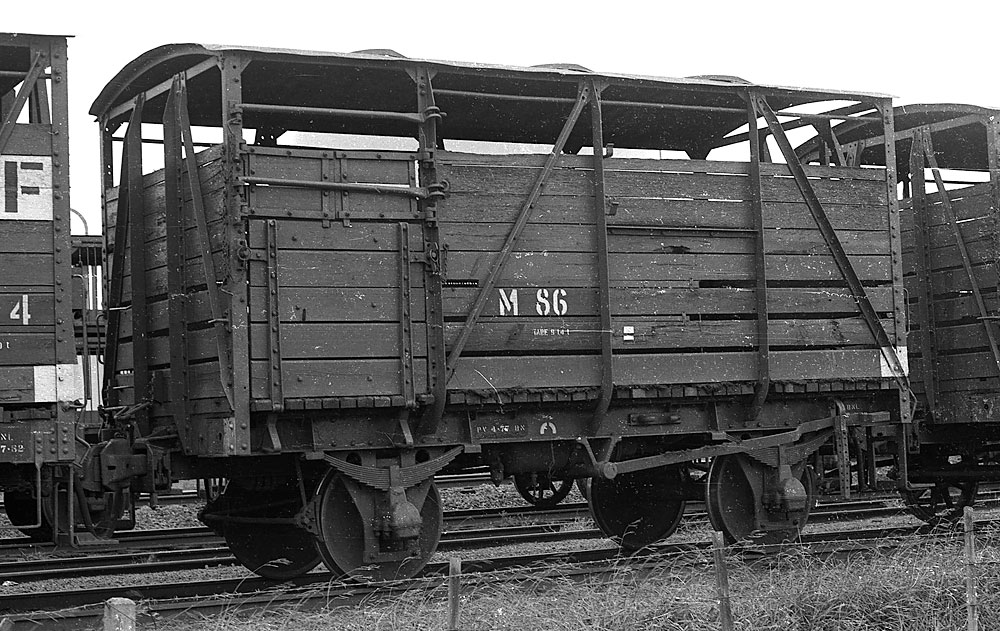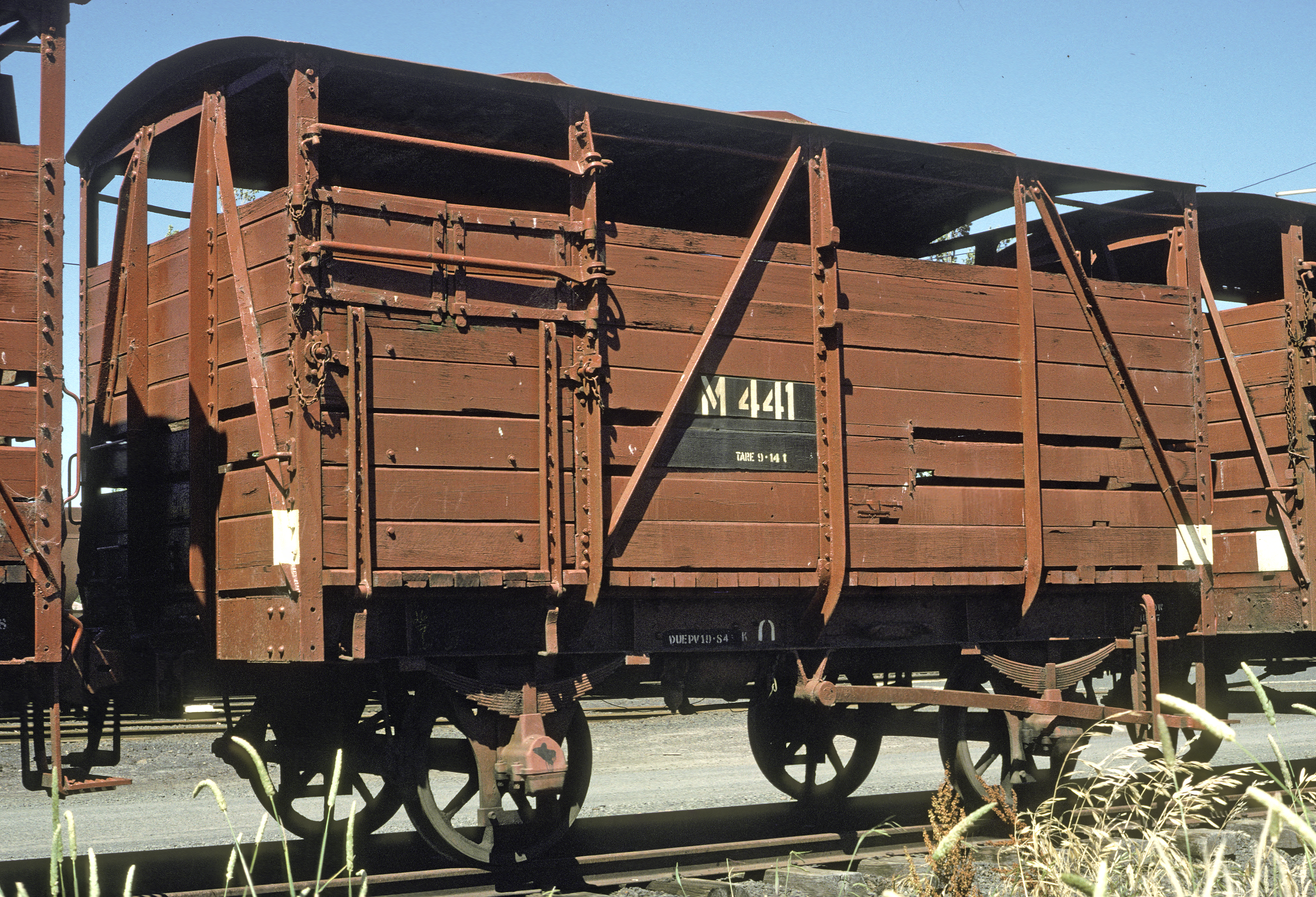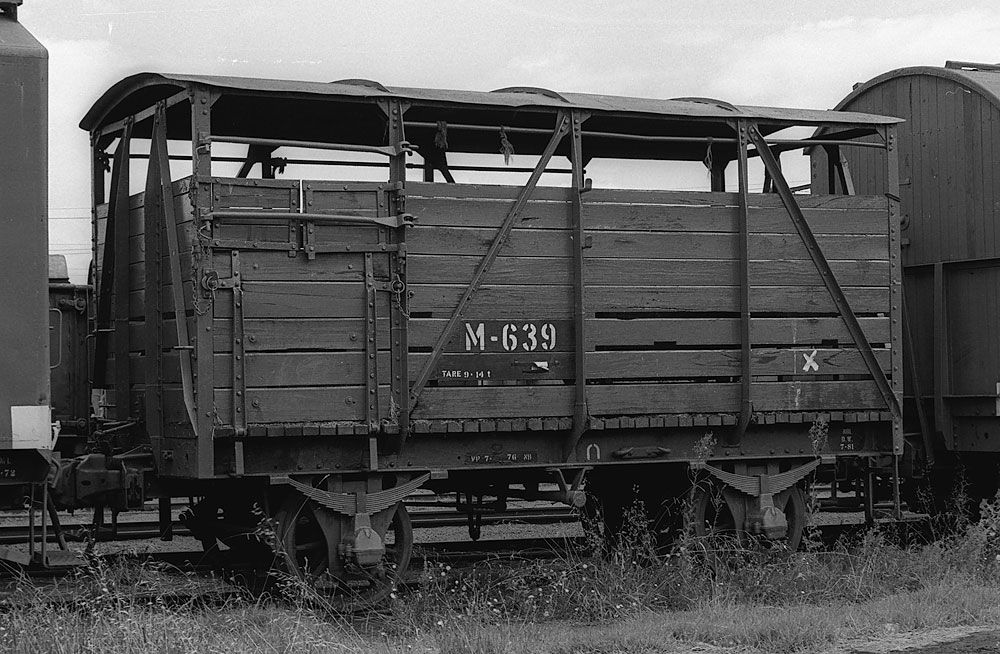M cattle wagons

M 393 at Camperdown. May 1 1978.Photo courtesy Geoff Winkler
| Although the M code was in continuous use for cattle vans since 1861 the "modern" M van described here first appeared in 1897. There were two main variations. M's 319 - 418 were slightly longer (20 feet versus 18 feet) than the rest of the class. The other variation was that the later M's (780 - 879) had different ends and GYstyle handbrakes. 3 M's had raised roofs for the transport of elephants in circus train. The way the diagonal bracing attached to the body also varied slightly within the class.
CLICK HERE for a 1948 VR article on the transport of stock |
||||||||||||||
|

ABOVE: M 3 at Seymour, 1978.Note how the diagonal bracing extends below the wagon floor.

ABOVE: This is an interesting photo. I was under the impression that no wagons with wooden underframes were equipped with Westinghouse air brakes (WHB) but this photo of M 10 shows that it did happen, perhaps it was a test. PJV's register data shows that this wagon was built 1878 and equipped with WHB 1889, it was scrapped in 1928 and its number was not re-used.

ABOVE: M 74 at Wodonga. March 1981 Photo courtesy Rob O'Regan

ABOVE: M 86 at Brooklyn. March 1978

ABOVE: M 140 at Tottenham. June 1982 (photo courtesy Rob O'Regan) BELOW: M 140 at Dandenong. May 6 1978.


Long M's 319 - 418

ABOVE: M 319 at Brooklyn. March 1978.
ABOVE: M 371 was built May 1891, autocoupled in 1933, it recieved a steel frame in 1952. photo courtesy SLV.

ABOVE: M 391 circa 1957. Built by Quayle & Williams, June 1891, it was auto-coupled in 1933 and was rebuilt with a steel frame Sep 1949. This particular wagon was converted to MB 2 in 1969. photo courtesy PROV



ABOVE: M 419, circa 1905. Built new 1897. This was the first steel framed M to be built, it must have been something of a test as no more M's would be built for another 12 years. This wagon was autocoupled Dec 1932. photo courtesy PROV.

ABOVE: M 441, built Oct 1909, autocoupled Sept. 1932, off register circa 1978. photo date 1978

ABOVE: A great builders photo of a modern M wagon. M 468 was built Oct. 1909. Apart from auto couplers and buffer removal the wagons went through their entire lives virtually unchanged. Note the dual waybill clips. The vertical straps on the door later were made from channel section steel. Official VR photo, Frank Kelly collection

M 639 has carried its last cattle and awaits the scrapper at Newport. Feb 1978.

M 679 at Brooklyn. Aug. 6 1978 (photo courtesy Geoff Winkler)

At least 3 M's had raised roofs as shown above, for circus elephant traffic.M 679 stored at Marong. March 28 1978.
BELOW: 2 views of M 773 at Brooklyn, Aug 6 1978 Photos courtesy Geoff Winkler



ABOVE: This photo shows the height difference between a standard M and the 3 "elephant M's" It also shows the length difference of the 319 - 418 group and the standard length M.

ABOVE: A circa 1934 view of M 690. Built Dec. 1921, autocoupled 1932 (Official VR photo, Frank Kelly collection)

ABOVE: M 696 circa 1935. Built new 1922, autocoupled 1932, scrapped 1974. (official VR photo)


Final Design

ABOVE: M 822 at Dandenong. May 6 1978.
M 780 - 879 had different ends from lower numbered M's as shown above and below
BELOW: M 827 at Newport. Feb 1978.



ABOVE: M 869 at Dandenong, April 30 1978

ABOVE: M's had their class and number info applied to a black patch, this wagon has the number directly applied to the wagon red and may have been a "one off"M 876 at Camperdown. May 1 1978 Photo courtesy Geoff Winkler
BELOW: End view of M 822


The majority of M's had the handbrake arrangement shown above, very late M's had the handbrake arrangement shown below (sometimes called a GY handbrake)
Also of note are the vertical braces. In the above photo the brace curves into the side sill, the later M's (780 - 879) and M's that were built prior to 1897 (up to M 418) that later got steel frames had braces that were straight and an additional gusset was required to attach them to the side sill. Also note the bottom of the diagonal brace extending below the floor level.



ABOVE: M 441 door detail

ABOVE: an interesting photo of a burnt out M showing the steel components at Bendigo workshops 1978 photo courtesy Peter J Vincent.